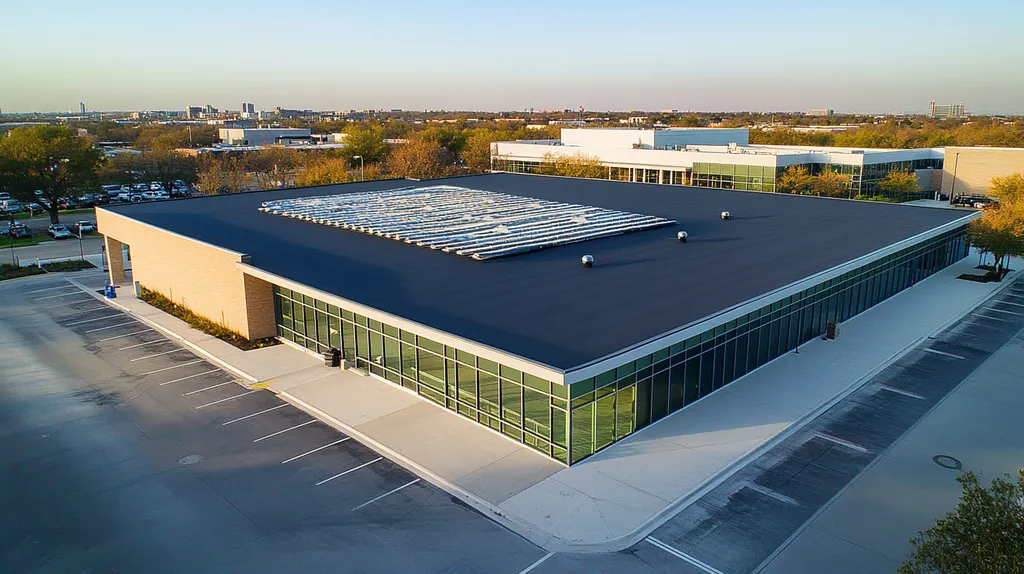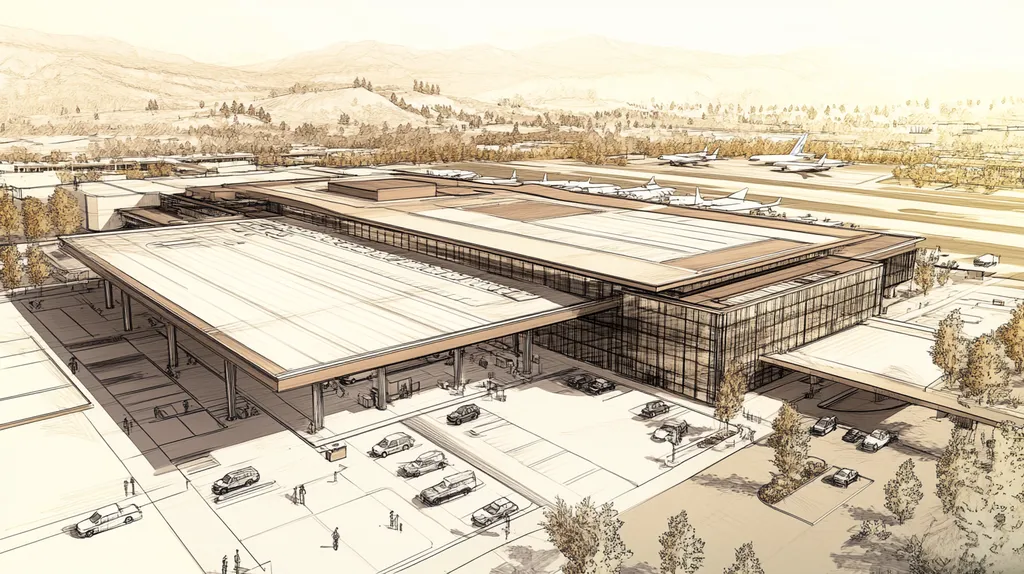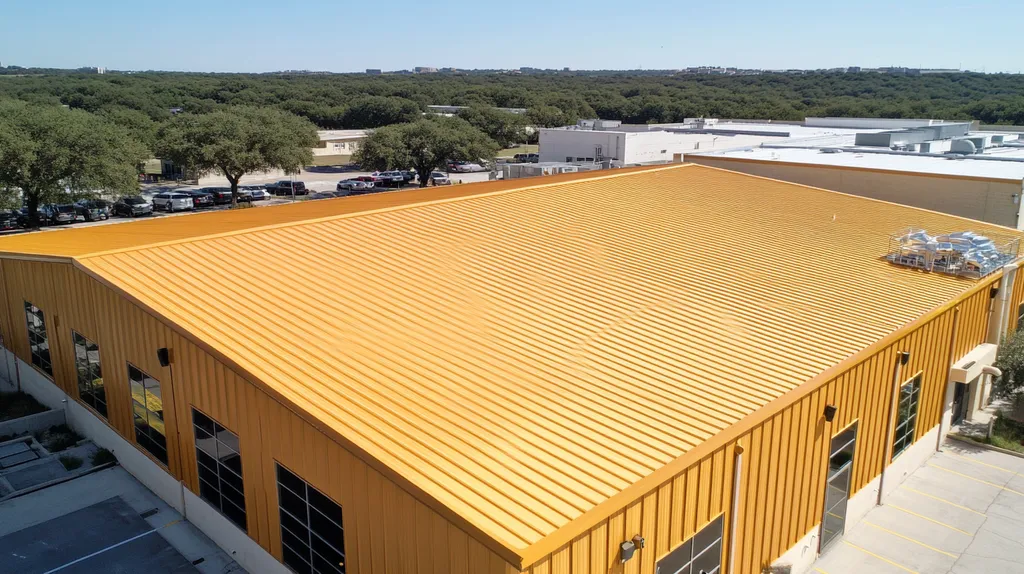Every year, improperly managed rooftop equipment causes over $3.3 billion in commercial roof damage across North America, reducing average roof lifespans by up to 70%.
From HVAC units to solar installations, modern commercial roofs must support an increasingly complex array of mechanical systems while maintaining structural integrity.
Understanding how these vital systems interact with your roof’s structure, drainage, and protective membrane can mean the difference between a roof that lasts decades and one that fails prematurely.
This comprehensive guide examines the critical factors that determine how rooftop equipment affects commercial roof durability, from proper installation methods to maintenance protocols that protect your investment.
SECTION 1: THE BASICS EXPLAINED
Commercial roofs bear a critical burden: supporting and protecting essential building equipment while maintaining structural integrity. Every square foot of rooftop space hosts an array of mechanical systems, from HVAC units to solar installations, each exerting unique pressures on the roofing system. Understanding how these elements interact with your roof is fundamental to preventing costly failures and extending your building’s operational lifespan.
What It Is (In Plain Language)
Rooftop equipment refers to any mechanical or electrical system installed on your commercial building’s roof. Common examples include air conditioning units, ventilation systems, satellite dishes, and increasingly, renewable energy installations like solar panels.
Each piece of equipment requires specific mounting systems, access paths for maintenance, and protective measures to prevent roof damage. These components must work in harmony with your roofing system rather than against it.
When properly installed, rooftop equipment enhances building performance while preserving roof integrity. However, improper installation or maintenance can create weak points where water infiltration, structural stress, and other problems begin.
The key is viewing rooftop equipment not as isolated units, but as integrated components of your building’s overall protection system.
Why It Matters (To Your Building)
The weight of rooftop equipment can significantly impact your building’s structural health. When equipment loads aren’t properly distributed, they can strain the roof’s structure, potentially leading to sagging or collapse. (source: Colony Roofers)
Beyond structural concerns, equipment placement affects drainage patterns. Poorly positioned units can create water dams, leading to ponding that accelerates roof deterioration and increases the risk of leaks.
Equipment maintenance activities can also damage roofing materials. Service technicians walking on the roof or dropping tools can puncture membranes and create vulnerable points in the roofing system.
These factors directly influence your building’s energy efficiency, maintenance costs, and overall lifespan. Proper equipment management is essential for protecting your investment.
How It Works
Rooftop equipment operates through a complex relationship with your building’s structural and mechanical systems. Each unit requires specific mounting configurations, weatherproofing methods, and maintenance protocols.
Support systems like equipment curbs and isolation rails distribute weight across the roof structure. These components must be properly flashed and sealed to maintain the roof’s waterproof integrity.
Regular equipment operation creates vibration, thermal movement, and moisture that affect surrounding roofing materials. Understanding these interactions helps prevent premature deterioration.
Effective equipment installation includes creating dedicated maintenance paths, ensuring proper drainage around units, and establishing clear protocols for service access that protect the roof surface.
SECTION 2: PRACTICAL APPLICATIONS
Rooftop equipment placement and management directly impacts commercial roof longevity, with studies showing that 40% of premature roof failures stem from equipment-related issues. Each piece of equipment introduces unique challenges that building owners must actively manage. Understanding these practical applications helps facility managers protect their investment while maximizing the functionality of essential rooftop systems.
Common Uses & Examples
Modern commercial roofs typically support multiple critical systems. HVAC units remain the most common, requiring substantial structural support and regular maintenance access. These systems often cover 15-20% of total roof area when including required clearance zones.
Solar panel installations have become increasingly prevalent, introducing new considerations for weight distribution and penetration points. These systems require specialized mounting hardware and often necessitate additional structural reinforcement.
Communication equipment, including satellite dishes and cellular antennas, presents unique challenges due to their need for precise positioning and frequent maintenance access. These installations often require multiple roof penetrations and specific mounting configurations.
By elevating equipment with proper support systems, owners can protect both the equipment and roofing membrane from moisture damage and premature wear. (source: Miro Industrial Solutions)
When You Need It Most
Critical timing for rooftop equipment management often coincides with seasonal transitions. Spring and fall present ideal windows for comprehensive equipment inspections and support system evaluations before extreme weather conditions arise.
Emergency situations demand immediate attention to prevent cascading failures. Water infiltration around equipment mounts requires swift intervention to prevent internal damage to both the equipment and building structure.
Building modifications or equipment upgrades necessitate careful planning and execution. These changes often require temporary protection measures and may impact existing roof warranties if not properly coordinated.
Preventive maintenance schedules should align with manufacturer recommendations for both the equipment and roofing system. This coordination helps minimize foot traffic and potential damage from service activities.
Interactions With Other Systems
Rooftop equipment interacts constantly with multiple building systems. Drainage patterns must account for equipment placement to prevent water accumulation, while ensuring adequate slope away from sensitive components.
Electrical and mechanical connections require careful integration with the roof’s waterproofing system. Each penetration point presents a potential vulnerability that must be properly sealed and regularly inspected.
Ventilation requirements often influence equipment positioning and can affect the roof’s thermal performance. Proper spacing between units helps maintain optimal airflow while preventing exhaust recirculation.
Access paths for maintenance must be clearly defined and reinforced to protect the roof surface. These pathways should integrate with existing structural supports while maintaining proper drainage patterns.
SECTION 3: KEY TERMINOLOGY DECODED
In the world of commercial roofing, understanding technical terminology isn’t just about speaking the language – it’s about protecting your investment and preventing costly failures. Every term, from load distribution to membrane compatibility, carries critical implications for how rooftop equipment affects your roof’s performance and longevity. Misinterpreting these terms can lead to installation errors that compromise roof integrity and accelerate deterioration.
Essential Terms Explained
Load-bearing capacity defines how much weight your roof can safely support. Getting this wrong when installing equipment can have devastating consequences, from membrane damage to structural failure.
Point loading occurs when equipment weight concentrates in specific areas rather than distributing evenly. This stress can create weak points in the roofing system and accelerate wear patterns.
Equipment curbs are raised platforms that elevate units above the roof surface. These critical components protect against water infiltration while providing stable mounting points for mechanical systems.
Membrane compatibility refers to how roofing materials interact with equipment supports and fasteners. Incompatible materials can degrade prematurely, creating potential failure points around equipment installations.
Industry Jargon Translated
Penetration flashings are waterproof seals around any equipment components that pass through the roof membrane. These critical junctions require precise installation to prevent leaks and maintain roof integrity.
Isolation pads provide vibration dampening between equipment and roof surfaces. These components prevent mechanical movement from transferring stress to the roofing system.
Wind uplift resistance measures how well rooftop equipment stays secured during high winds. This factor becomes increasingly important as equipment profiles and weights change.
Traffic pads create protective walking surfaces for maintenance access. These pathways prevent direct contact between service personnel and the roof membrane.
Measurement & Units Simplified
Dead load represents the constant weight of permanently installed equipment. Understanding this measurement ensures your roof structure can support planned installations without compromising its integrity.
Live load accounts for temporary weight from maintenance activities, snow accumulation, and wind forces. This variable factor must be considered when calculating total roof capacity.
Thermal movement measures how materials expand and contract with temperature changes. Equipment mounting systems must accommodate this movement to prevent stress on connection points.
Drainage slope indicates how effectively water moves away from equipment installations. Proper measurement ensures water doesn’t pool around sensitive components or create pressure points on the roof surface.
SECTION 4: DECISION FACTORS
Every decision about rooftop equipment carries significant implications for commercial roof durability. Statistics show that 60% of commercial roof failures stem from equipment-related issues, making these choices critical to building protection. Property owners face increasingly complex decisions about equipment selection, placement, and maintenance that directly impact their roof’s performance and longevity.
Cost Considerations
Initial equipment costs represent only a fraction of the total investment impact on commercial roofs. Premium equipment often includes enhanced mounting systems and weatherproofing features that protect roof integrity.
Installation quality significantly influences long-term expenses. Professional installation may cost more upfront but prevents costly repairs from improper mounting or inadequate support systems.
Maintenance accessibility affects ongoing costs. Equipment positioned with adequate clearance and appropriate support structures reduces service time and minimizes potential roof damage during repairs.
By elevating equipment with proper support systems, owners can protect both their equipment and roofing materials from premature wear while reducing long-term operational costs. (source: Miro Industries)
Performance Trade-offs
Equipment performance directly impacts roof durability through factors like heat output, vibration, and drainage requirements. High-efficiency units typically generate less heat stress on surrounding roofing materials.
Size and weight specifications must balance operational needs with structural limitations. Oversized equipment can create excessive point loads, while undersized units may operate inefficiently and require more frequent maintenance access.
Positioning affects both equipment efficiency and roof protection. Proper spacing between units prevents exhaust recirculation while maintaining adequate drainage paths.
Modern equipment often includes integrated protection features that help preserve roof integrity. These design elements can significantly extend the service life of both the equipment and roofing system.
Lifespan & Durability Factors
Equipment durability directly correlates with roof longevity. Units designed for harsh outdoor conditions typically include corrosion-resistant materials and robust weatherproofing that protect underlying roof structures.
Support system quality plays a crucial role in equipment longevity. Properly engineered mounting solutions prevent movement and vibration that could damage roofing materials.
Material compatibility between equipment supports and roofing systems affects long-term performance. Incompatible materials can accelerate deterioration through chemical reactions or physical stress.
Regular inspection and maintenance schedules help identify potential issues before they compromise roof integrity. Preventive care of both equipment and support systems extends the functional life of the entire roofing system.
SECTION 5: COMMON CHALLENGES
Commercial rooftop equipment challenges represent a critical intersection of building performance and structural integrity. Industry data shows that 70% of premature roof failures stem from equipment-related issues, with repair costs often exceeding initial installation expenses. Understanding and addressing these challenges directly impacts building operations, energy efficiency, and long-term maintenance costs.
Frequent Problems & Solutions
Water infiltration around equipment mounts remains the leading cause of roof damage. Improper flashing, deteriorated seals, and compromised equipment curbs create vulnerable points where moisture can penetrate the roofing system.
Vibration from operational equipment frequently loosens fasteners and creates membrane stress points. Installation of proper isolation systems and regular torque checks help prevent these issues from escalating into major failures.
By elevating equipment with proper support systems, building owners can protect both their equipment and roofing materials from moisture damage, debris accumulation, and premature wear. (source: Miro Industries)
Temperature fluctuations around equipment zones create expansion and contraction stress. Installing appropriate expansion joints and using temperature-resistant materials helps mitigate these thermal impacts.
Warning Signs To Watch For
Surface deterioration near equipment installations often signals mounting system failures. Watch for membrane wrinkles, tears, or displacement that indicates structural stress points.
Unusual equipment noise or vibration suggests mounting system compromise. These symptoms frequently precede more serious roofing damage and require immediate investigation.
Standing water around equipment bases indicates drainage problems. Even minor ponding can accelerate material degradation and should trigger prompt corrective action.
Interior stains or moisture marks often trace back to equipment-related leaks. Regular ceiling inspections help identify these issues before significant damage occurs.
Preventative Approaches
Implementing comprehensive maintenance schedules significantly reduces equipment-related roof damage. Regular inspections should examine both equipment condition and mounting system integrity.
Strategic equipment placement optimizes weight distribution and drainage patterns. Proper spacing between units prevents exhaust recirculation while maintaining adequate maintenance access.
Installing walk pads and designated service paths protects roofing materials during maintenance activities. These protective measures should integrate with existing drainage patterns.
Documentation of all equipment modifications and repairs helps track potential problem areas. Maintaining detailed records enables proactive intervention before minor issues become major failures.
SECTION 6: NEXT STEPS & RESOURCES
The complexity of rooftop equipment management demands strategic planning and continuous education. Industry data reveals that 75% of commercial roof failures stem from inadequate equipment installation or maintenance protocols. Understanding available resources and following established guidelines can mean the difference between a roof that lasts decades and one that fails prematurely. Property owners who take proactive steps in equipment management typically see a 40% reduction in emergency repairs.
Questions To Ask Providers
Start by verifying the provider’s experience with your specific rooftop systems. Request detailed documentation of past installations similar to your equipment configuration and ask about their preventive maintenance protocols.
Equipment mounting specifications deserve particular scrutiny. Question providers about their preferred support systems, weight distribution methods, and how they prevent thermal movement from compromising roof integrity.
Warranty implications must be clearly understood before proceeding. Discuss how equipment installation affects existing roof warranties and what additional coverage may be necessary for new components.
Establishing clear maintenance responsibilities is crucial. Define who handles routine inspections, emergency repairs, and scheduled equipment servicing to prevent gaps in system oversight.
By elevating equipment with proper support systems, owners can protect both their equipment and roofing materials from moisture damage while extending operational life. (source: Miro Industries)
Industry Standards & Guidelines
NRCA guidelines provide essential frameworks for equipment installation and maintenance. Their technical bulletins offer specific recommendations for different equipment types and roofing systems.
FM Global standards outline crucial requirements for wind resistance and structural support. These specifications help ensure equipment remains secure during severe weather events.
ASHRAE guidelines address equipment placement and operational efficiency. Their recommendations balance performance needs with roof protection requirements.
Local building codes establish minimum requirements for equipment installation. Understanding these regulations helps prevent compliance issues while ensuring basic safety standards.
Further Learning Simplified
Professional certification programs offer structured learning paths. Organizations like NRCA and IIBEC provide targeted courses on equipment-roof interaction and maintenance protocols.
Technical webinars deliver current insights on emerging technologies. These sessions often include case studies demonstrating successful equipment integration strategies.
Industry publications provide ongoing education opportunities. Subscribing to recognized sources keeps stakeholders informed about evolving best practices and new equipment options.
Manufacturer training programs offer equipment-specific knowledge. These resources help facility managers understand unique maintenance requirements and potential roof impact factors.
The Bottom Line
With over $3.3 billion in annual roof damage linked to equipment-related issues, proper management of rooftop installations has never been more critical for commercial property owners.
Today’s roofing systems must support increasingly complex mechanical arrays while maintaining structural integrity against mounting environmental pressures.
Success requires viewing equipment not as isolated units, but as integrated components of the total building envelope system.
By following industry standards for equipment selection, installation, and maintenance while implementing regular inspection protocols, facility managers can extend roof lifespans by up to 40% while significantly reducing operational costs.
The future of commercial roofing depends on balancing essential equipment needs with proven protection strategies that preserve both system functionality and structural integrity.
FREQUENTLY ASKED QUESTIONS
Q. How does rooftop equipment affect a commercial roof’s durability?
A. Rooftop equipment can exert significant stress on a commercial roof. Improper installation or maintenance can lead to weak points, which may result in leaks, structural damage, or even premature roof failure. Understanding how each piece interacts with the roof is crucial for longevity.
Q. What challenges do industrial roofs face due to equipment placement?
A. Equipment placement on industrial roofs can lead to issues like water pooling and drainage problems. If not carefully managed, these challenges can accelerate wear and tear, leading to costly repairs. Proper equipment placement contributes significantly to overall roof performance.
Q. What is load-bearing capacity in commercial roofing?
A. Load-bearing capacity refers to the weight a commercial roof can safely support. Understanding this factor is essential when installing rooftop equipment, as exceeding this capacity can result in severe structural issues, compromising the roof’s integrity over time.
Q. How can I prevent premature roof failure with equipment management?
A. Preventing premature roof failure involves regular inspections and proactive maintenance. Ensure equipment is properly installed and that drainage paths are clear. Address any signs of stress or degradation around equipment promptly to maintain the roof’s integrity.
Q. What weight considerations should I have for industrial roof equipment?
A. When considering equipment for industrial roofs, it’s crucial to evaluate both the dead load and live load. Equipment should be selected based on how it distributes weight across the roof to avoid creating stress points that could lead to structural damage.
Q. What warning signs indicate rooftop equipment issues?
A. Warning signs include visible surface deterioration, unusual noises from equipment, and any standing water around equipment bases. These indicators suggest that equipment is not functioning properly and may lead to more severe issues if not addressed.
Q. How can I choose the right equipment for my commercial roof?
A. Selecting the right equipment involves understanding your roof’s load capacity and operational needs. It’s important to consider long-term durability, maintenance accessibility, and potential impact on existing roofing materials to ensure a good fit and performance.











